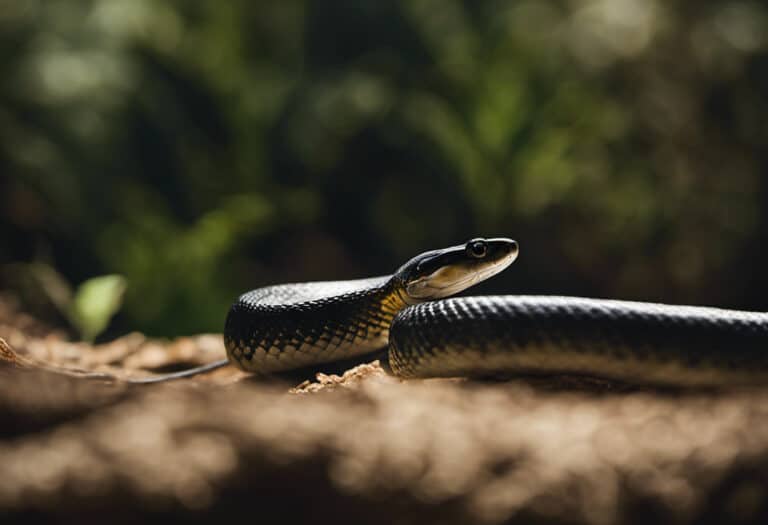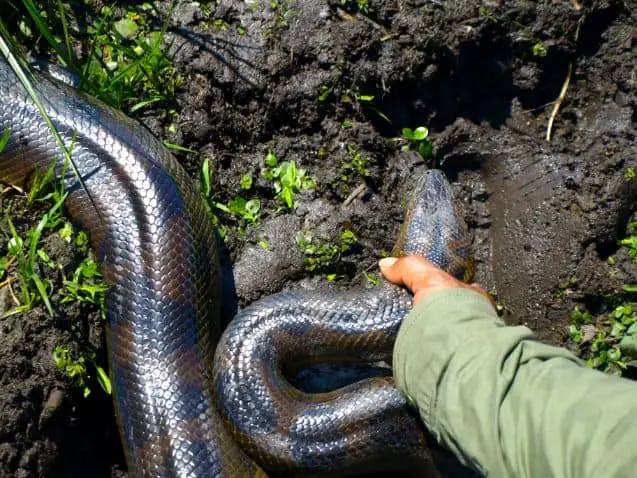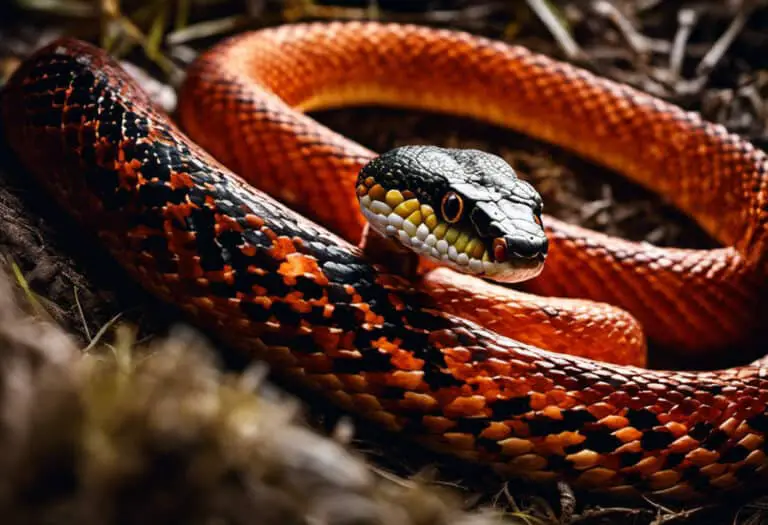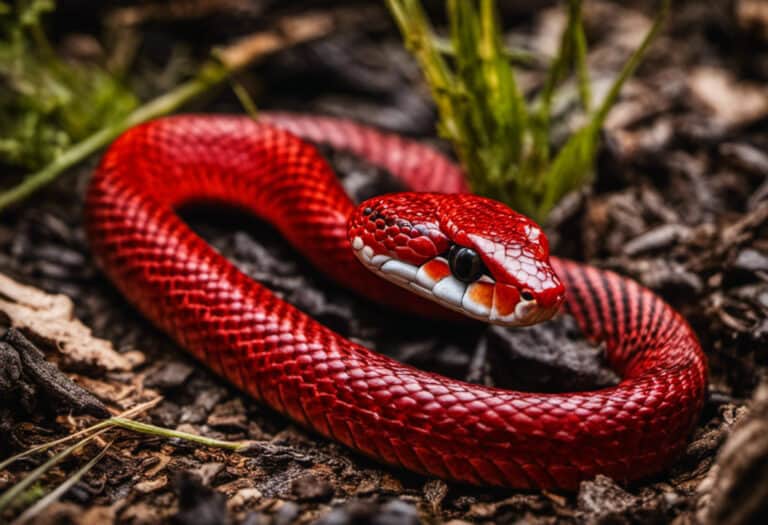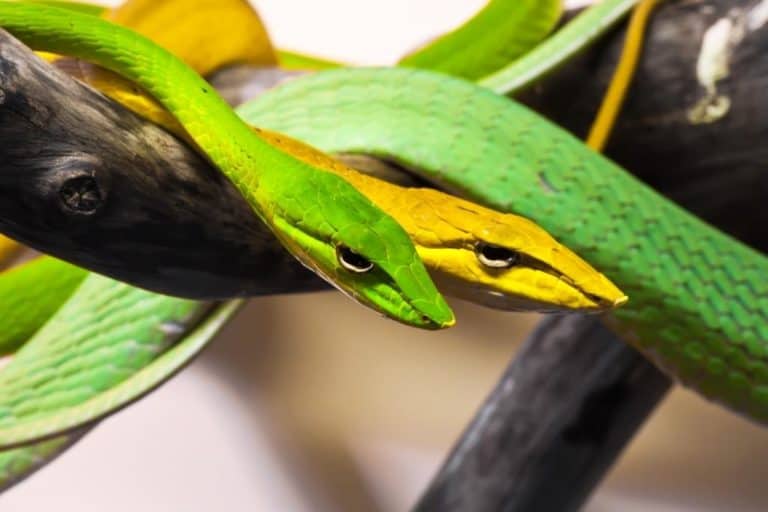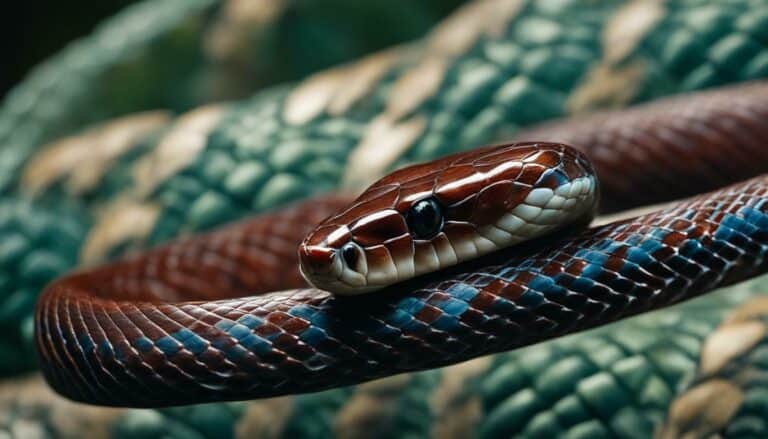Curious Facts: Are Snakes Active at Night?
When it comes to snake behavior, there is no straightforward answer to whether snakes are active at night. The truth is, it depends on the species. Some snakes are nocturnal, while others are diurnal.
Nocturnal snakes typically hunt for food and move around at night, using vibrations to navigate, rather than sight. On the other hand, diurnal snakes are more active during the day and sleep in shelters at night.
Snakes require warmer temperatures for their bodies to function properly, so they often take shelter in burrows or other hiding places during the cooler night hours. In captivity, it’s crucial to provide them with a safe and secure hide to rest in.
Snakes sleep for approximately 16 hours per day on average, but this can vary depending on factors such as the time of year and their eating schedule. During winter, they enter a state called brumation, similar to hibernation, in which they become less active and slow down in response to colder temperatures.
Overall, snake behavior is complex and varies depending on many factors. Understanding these habits is essential for anyone encountering snakes in the wild or caring for them in captivity.
Key Takeaways:
- Some snake species are nocturnal, while others are diurnal.
- Nocturnal snakes use vibrations to navigate, while diurnal snakes are more active during the day and sleep at night.
- Snakes require warmer temperatures to function properly, often taking shelter at night.
- Snakes sleep for approximately 16 hours per day on average, but this can vary depending on factors such as the time of year and their eating schedule.
- During winter, they enter a state called brumation, similar to hibernation.
Nocturnal Snakes
Some snake species are considered strictly nocturnal. These snakes are most active at night and spend the daytime resting in burrows. Nocturnal snakes use the cover of darkness to move and hunt without detection, relying on their ability to detect vibrations in the ground and some can also detect heat. Examples of strictly nocturnal snake species include death adders, little whip snakes, and many python species.
Nocturnal snakes are well adapted to hunting in the dark. They use their sense of smell, heat vision, and sensitivity to vibrations to locate prey. They are also well camouflaged and can move silently to avoid detection by predators.
Nocturnal snakes also have unique physical characteristics that allow them to thrive in the dark. Some species have enlarged pupils that allow them to gather more light, while others have specialized cells in their eyes that can detect infrared radiation, allowing them to detect heat from potential prey or predators.
“Nocturnal snakes use the cover of darkness to move and hunt without detection.”
It is important to note that not all snakes are strictly nocturnal. Many species are diurnal and adapt their activity patterns to environmental conditions. However, understanding the habits of nocturnal snakes can help people minimize encounters with them and reduce the risk of venomous snake bites.
Diurnal Snakes
The majority of snakes are diurnal creatures, meaning they are active during the daytime rather than at night. Unlike nocturnal snakes, diurnal snakes sleep in shelters at night, requiring warmer temperatures for their bodies to function properly. They tend to retreat to burrows or other shelters to keep warm during cooler nighttime temperatures.
On average, snakes sleep for approximately 16 hours per day, with their sleeping time increasing after eating. They prefer to sleep in secure places, such as holes in the ground, hollowed-out tree trunks, under rocks, or in leaf litter. In captivity, it is important to provide hiding places for them to retreat to when they are ready to sleep or feeling threatened.
While diurnal snakes are more likely to be active during the day, they can also be active at night if they need to feed, find shelter, or escape danger. Factors such as temperature, food availability, predators, climate, and weather conditions can also influence a snake’s activity patterns.
Their ability to be active during both daylight and nighttime hours makes diurnal snakes more versatile than their nocturnal counterparts. However, they still require adequate access to food and shelter to maintain their activity levels. Understanding the behavior of diurnal snakes can help us appreciate their place in the natural world and how they adapt to their surroundings.
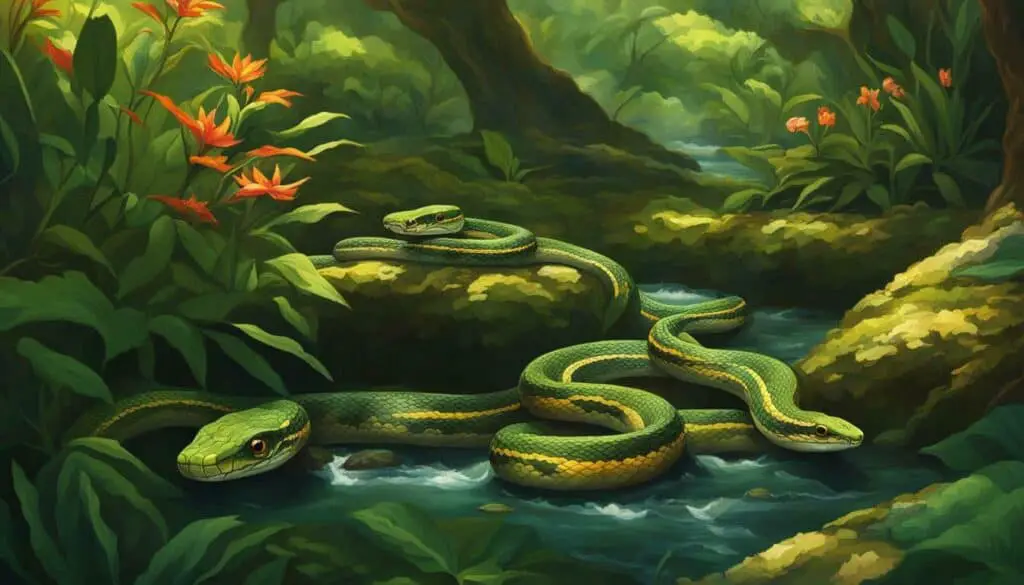
Temperature
Ambient temperature is one of the most significant factors that influence a snake’s activity. As cold-blooded animals, snakes rely on their environment to regulate their body temperature. In temperate climates, snakes are most active during the daytime when the sun provides warmth. As the temperature drops in the evening, snake activity decreases, and they may seek shelter in protected areas.
However, in hotter climates, snakes may be more active at night when temperatures are more favorable for their activity. This is particularly true for species that are adapted to the desert environment, such as the sidewinder rattlesnake. They have evolved to hunt and forage at night when temperatures are cooler and more conducive to their activity.
It is not just the absolute temperature that affects snake behavior, but also the temperature gradient. Snakes will move between warmer and cooler areas to regulate their body temperature. They may be more active during the early morning and late afternoon, as the temperature begins to change, and the temperature gradient is most favorable.
Overall, snake activity is highly dependent on temperature and its gradients. Different species have adapted to different environments and temperature ranges, so it is essential to understand the behavior of snakes in your area and take measures to avoid conflicts.
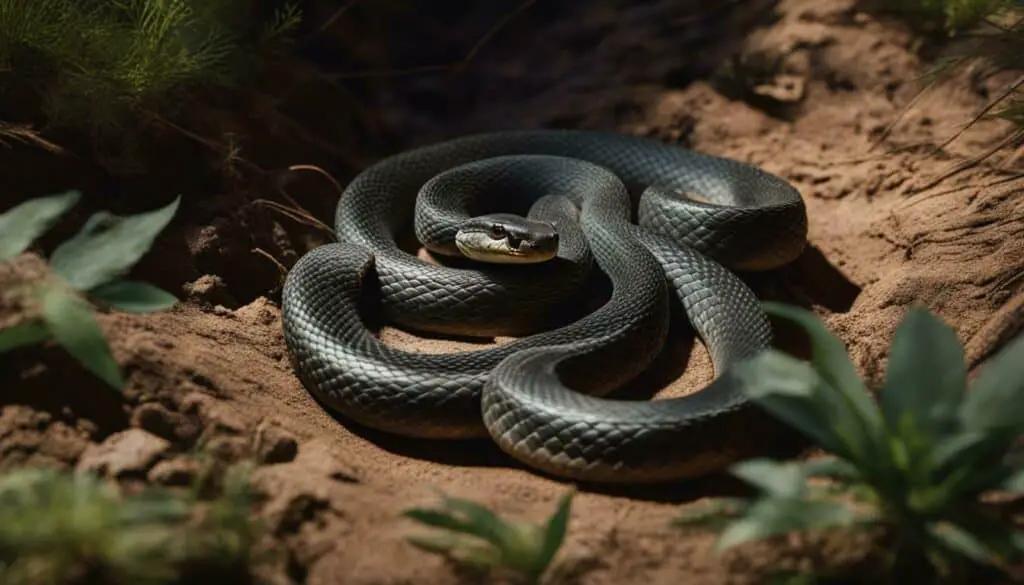
Food and Predators
The availability of food sources also plays a role in a snake’s activity pattern. Snakes are opportunistic hunters, meaning they will hunt and eat whenever a suitable prey item is available. If food is scarce, snakes may become less active and conserve energy until a food source becomes available. In contrast, if food is abundant, they may become more active and spend more time hunting.
Predators also play a significant role in snake behavior. Snakes have numerous predators, including birds of prey, other snakes, and mammals such as raccoons and coyotes. When predators are present, snakes may modify their behavior to minimize their risk of being caught. For example, snakes may be more active during the daytime to avoid nocturnal predators or choose to hide in safer locations.
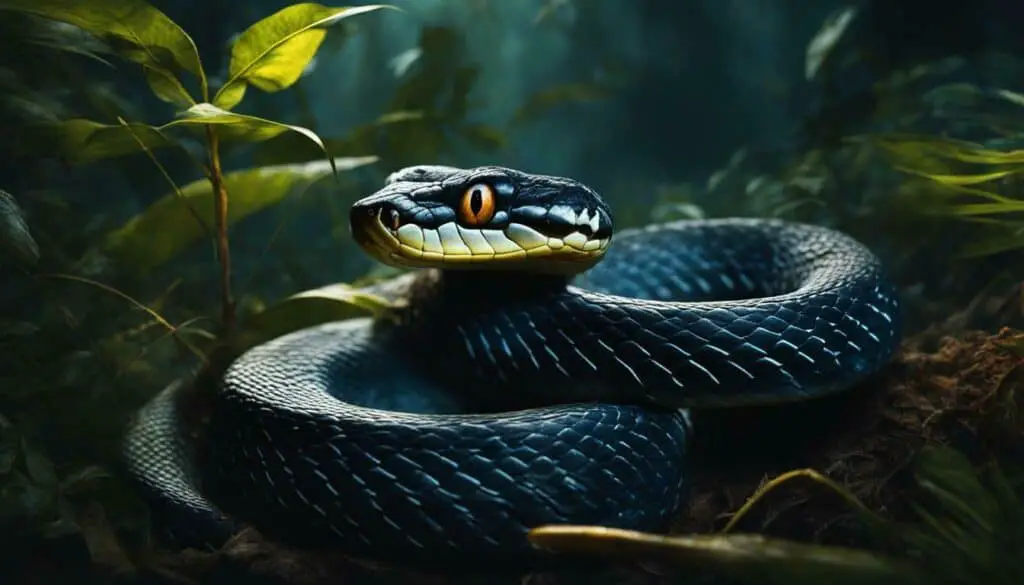
“Snakes are opportunistic hunters, meaning they will hunt and eat whenever a suitable prey item is available.”
Climate and Weather Conditions
Climate and weather conditions also influence snake activity patterns. As cold-blooded animals, snakes rely on external temperatures to regulate their metabolic processes and behavior. During the winter, snakes enter a state of brumation, which is similar to hibernation in mammals. They become less active and slow down due to colder temperatures. However, during warmer months, snakes become more active and move around more frequently.
Snakes also adjust their behavior based on other weather conditions, such as humidity and moonlight. For example, some snakes are more active during periods of high humidity, while others are more active during dry conditions. Moonlight can also affect snake activity, with some species being more active during full moon nights.
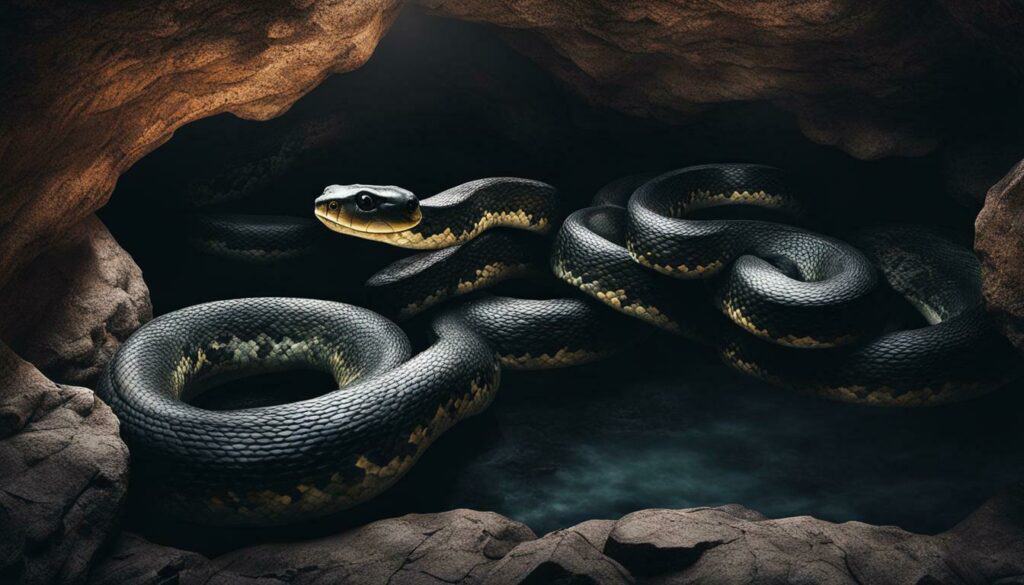
Overall, it’s important to understand the impact of climate and weather on snake behavior. By recognizing their patterns and adjusting your own behavior accordingly, you can minimize potential encounters and stay safe.
Conclusion
In conclusion, snakes’ behavior and activity patterns vary greatly among species. The complexity of snake behavior is influenced by multiple factors, including temperature, food availability, predators, climate, and weather. Some snakes are nocturnal, relying on vibrations rather than sight to hunt and move in the dark. Others are diurnal, active during both day and night.
Nocturnal snakes often seek shelter in burrows, hollowed-out tree trunks, under rocks, or within leaf litter during the daytime. During the night, they take advantage of the cover of darkness to hunt and move without detection.
Snakes in colder climates may enter a state of brumation during the winter, where their activity levels decrease, and they conserve their energy.
It’s important to understand the habits of snakes and avoid close contact with them to minimize any potential harm. Appreciate the diversity and complexity of these fascinating creatures and their nighttime habits.
FAQ
Q: Are all snakes active at night?
A: No, not all snakes are active at night. Some snake species are strictly nocturnal, while others are diurnal and active during both daytime and nighttime.
Q: How do nocturnal snakes hunt in the dark?
A: Nocturnal snakes rely on their ability to detect vibrations in the ground rather than sight to hunt in the dark.
Q: When are diurnal snakes most active?
A: Diurnal snakes are most active during the daytime but may also be active at night if they need to feed, find shelter, or escape from danger.
Q: What factors influence snake activity patterns?
A: Snake activity patterns are influenced by factors such as temperature, food availability, predators, climate, and weather conditions.
Q: How does temperature affect snake activity?
A: Snakes are most active during the daytime in temperate climates when the sun provides warmth. In hotter climates, they may be more active at night when temperatures are optimal.
Q: Do snakes adapt their activity based on food availability?
A: Yes, snakes may modify their behavior and be active during less ideal times if food sources are more plentiful.
Q: How do predators affect snake activity?
A: Snakes adapt their activity patterns to minimize the risk of falling prey to predators. They are more likely to be active during hours when the risk is lower.
Q: What is brumation?
A: Brumation is a state similar to hibernation that snakes in colder climates enter. It allows them to conserve energy during periods of colder weather.
Q: How do weather conditions influence snake activity?
A: Snakes are more active on warmer nights and during cloudy nights with little moonlight, as these conditions provide better cover from predators. They also prefer higher humidity.
Q: What makes snakes fascinating creatures?
A: Snakes are fascinating due to their diverse activity patterns, adaptations to their environment, and the sheer number of species found across the globe.
